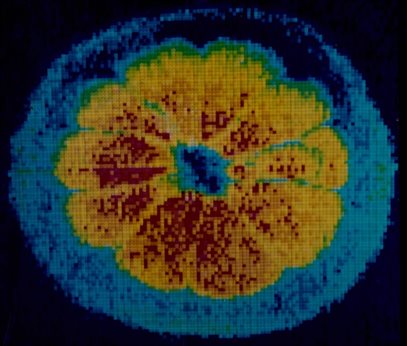Raymond Andrew
Edward Raymond Andrew was born in Boston, Lincolnshire in 1921 and was educated at Wellingborough School. He graduated from Christ's College, Cambridge during the Second World War, then undertook wartime service as a Scientific Officer at the Telecommunications Research Establishment (later the Royal Radar Establishment) in Malvern, Worcestershire, studying the attenuation of microwave radar signals through gun flashes. After the war he returned to Cambridge where he completed a doctorate. In 1948 he received a Commonwealth Fund Fellowship to spend a postdoctoral year at Harvard University, one of the pioneering institutions for nuclear magnetic resonance spectroscopy (NMR), in the laboratory of Professor Edward Purcell.
Andrew became one of the first practitioners of NMR in the UK when in 1949 he took up a lectureship at the University of St Andrews. He was appointed Professor of Physics at the University College of North Wales, Bangor, in 1954 and, in the following year, published the first textbook on NMR. Whilst at Bangor in 1958, Andrew discovered the technique of 'magic angle spinning' for appraising solids with NMR. This technique involved rapidly spinning samples at an angle to a magnetic field, and became the foundation of modern high resolution NMR studies for chemical structures.
In 1964, Andrew was appointed Lancashire-Spencer Professor and Head of the Physics Department at the University of Nottingham. He continued his work on using rapid rotation of samples for high resolution studies, and also carried out research into how NMR could form the basis of a medical imaging technique which was later named magnetic resonance imaging (MRI). He established Nottingham as a centre for research into MRI, and his research group was one of the first to obtain detailed MRI images of the human wrist and brain. He was also Dean of the Faculty of Science from 1975 to 1978.
In 1983, Andrew left Nottingham and became Graduate Research Professor at the University of Florida, Gainesville. He continued his NMR and MRI research, and played a role in establishing the US National High Magnetic Field Laboratory in Tallahassee. He retired in 1999.
Andrew was elected a Fellow of the Royal Society in 1984. He died on 27 May 2001.

MRI image of a cross-section through a lemon (PRA/5/2/2/10)
Principal subject areas within the collection
Andrew’s published papers form a large part of the collection. There is also a substantial amount of correspondence, which Andrew exchanged with scientists around the world for more than half a century.
Also present are research notes and experimental results relating to magic angle spinning and MRI, material relating to lectures Andrew gave and conferences he attended, notebooks from Andrew’s work at the Telecommunications Research Establishment during the Second World War, papers from his time at the University of Florida, material relating to his membership of scientific societies, and around 750 35 mm slides showing graphs and diagrams relating to magic angle spinning and MRI.
The catalogue of the Raymond Andrew collection is available and searchable through the Manuscripts Online Catalogue: catalogue record
Next page: Brian Worthington